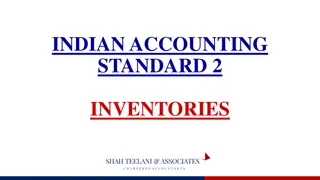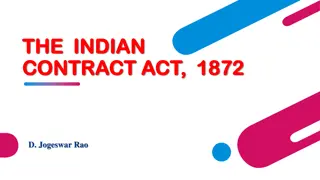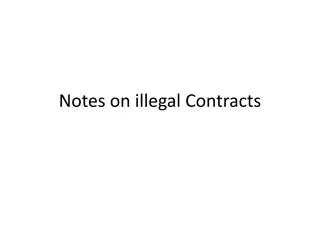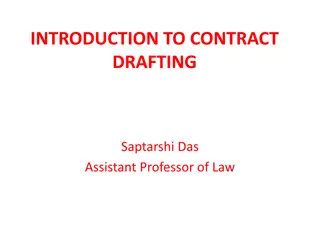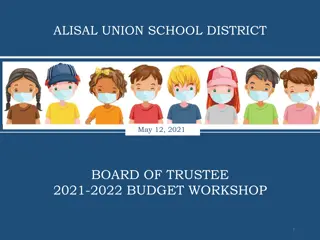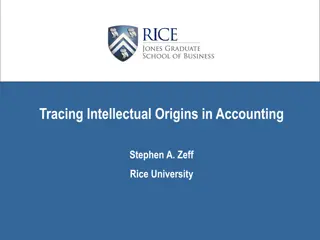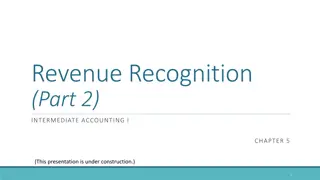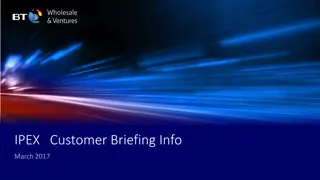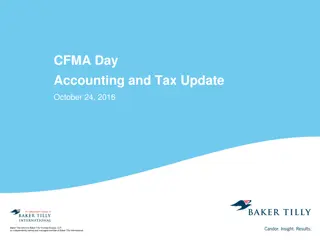Indian Accounting Standard 115: Revenue from Contracts with Customers
Revenue recognition is crucial in financial reporting. Ind AS 115 provides guidelines on recognizing revenue from contracts with customers, emphasizing five key steps requiring judgment and potential mindset shifts. The steps include contract identification, performance obligations, transaction pricing, and more, with potential impacts on current practices. Damania & Varaiya offer insights into these steps and the scope of contracts covered. Understanding and applying these standards is essential for accurate financial reporting.
Uploaded on Mar 02, 2025 | 1 Views
Download Presentation

Please find below an Image/Link to download the presentation.
The content on the website is provided AS IS for your information and personal use only. It may not be sold, licensed, or shared on other websites without obtaining consent from the author.If you encounter any issues during the download, it is possible that the publisher has removed the file from their server.
You are allowed to download the files provided on this website for personal or commercial use, subject to the condition that they are used lawfully. All files are the property of their respective owners.
The content on the website is provided AS IS for your information and personal use only. It may not be sold, licensed, or shared on other websites without obtaining consent from the author.
E N D
Presentation Transcript
1 INDIAN ACCOUNTING STANDARD 115 REVENUE FROM CONTRACTS WITH CUSTOMERS
2 Revenue from Contracts with customers (subject to specific exceptions) including contracts for : -Sales ofgoods -Rendering of Services including construction services - Licensing of Intellectual property Exchange of Non-monetary Assets In Scope Contracts within the scope of -Ind AS 17 Leases - Ind AS 104- InsuranceContracts -Ind AS 39/Ind As 109- FinancialInstruments - Ind As 41- Agriculture (non contractual ) - Investment Properties and Biological Assets Out Scope Damania & Varaiya
3 Damania & Varaiya
4 Ind AS 115 - Revenue from Contracts with Customers The five steps above a) Needs Significant judgement to apply b) Most entities should expect some level of change from current practice. c) A change of mindset about revenue recognition might be needed to migrate from an evaluation of Risk and rewards under existing guidance to an evaluation of transfer of control under the new standard. Damania & Varaiya
5 Ind AS 115 - Revenue from Contracts with Customers Step 1 Identify the contract An agreement between two or more parties which creates enforceable rights and obligations The Parties to the contract have approved the contract and are committed to perform respective obligations. The Contract has commercial substnace and it is probable that the entity willl collect cash consideration The entity can identify the payment terms for the goods or services to be rendered. The entity can identify each party s rights regarding the goods or services to be transferred. Damania & Varaiya
6 Step 2 Identify the performance obligations Identifying performance obligations is critical to measurement and timing of recognition Performance obligations are promises in a contract that create valid expectation that the entity will provide/transfer goods or services and such promises may be Explicit Implicit, or Arise from customary business practices Damania & Varaiya
7 Step 3 Determine the transaction price More specific guidance covering: A Significant financing component constraint on variable consideration non-cash consideration Amount payable to a customer to determine the transaction price Damania & Varaiya
8 Example: Ind AS 18 vs. Ind AS 115 X enters into a 12-month telecom plan with Airtel . The terms of plan are as follows: X pays monthly fixed fee is INR 5,000. X receives a free handset at the inception of the plan. Airtel sells the same handsets for INR 25,000 and the same monthly prepayment plans without handset for INR 4,000/month. How should Airtel recognize the revenues from this plan in line with Ind AS 18 and Ind AS 115? Damania & Varaiya
9 Ind AS 115 Revenue under Ind AS 18 Revenue under Ind AS 115 identify the contract first (step 1), No guidance on how to identify these components & how to allocate sale price identify all performance obligations (step2) being a) Delivery of handset & b) service The transaction price (step 3) is INR 60,000 being 5,000 X 12 months allocate that transaction price of INR 60k to individual performance obligations (step4) Performance obligation Stand-alone sellingprice Revenue (relativeselling price =60,000*%) % ontotal 34% step 5 is to recognize the revenue when Airtel satisfies the performance obligations. Handset 25,000 20,500 Networkservices 48,000(=4000*12) 66% 39,500 Total 73,000 100.0% 60,000 Damania & Varaiya
10 Ind AS 115 - Revenue from Contracts with Customers What s the Impact of the Ind AS 15? The biggest impact of the new standard is that the companies will report profits in a different way and profit reporting patterns will change. In our telecom example, Airtel may report loss in the beginning of the contract and then steady profits under Ind AS 18, because they recognized the revenue in line with the invoicing to customers. Under Ind AS 115, Airtel reported profits are the same in total, but their pattern over time is different. Why does it matter? Well, because some contracts surpass one accounting period. They are long-term and reporting revenues in incorrect accounting periods might cause wrong taxation, different reporting to stock exchange and other things, too. Damania & Varaiya
11 Time value of money Adjust consideration, if there is a significant financing component: optional if period between payment and performance less than year captures advanced payments Consider: difference between consideration and the cash selling price, and Then combined effect of both: time between transfer of goods/services and customer payment the prevailing interest rates in the relevant market Specific examples of when there is no significant financing component e.g. transfer at customers discretion (customer loyalty programmes) Damania & Varaiya
12 Variable consideration Included in the transaction price only if it is highly probable that there will not be a significant revenue reversal Uncertainty over long period of time Limited experience with similar contracts Susceptible to factors outside control Broad range of outcomes Key effects Must recognise minimum amount that is highly probable of not reversing Reassessed at the end of each reporting period Damania & Varaiya
13 Sales and usage-based royalties exception For licences of intellectual property with a sales or usage based royalty, revenue recognised only when sales/usage occurs highly probable constraint does not apply not meant to be applied by analogy The challenges? What is a licence? What is a sales based or usage based royalty? What is intellectual property? Damania & Varaiya
14 Step 4 Allocate the transaction price to seprate perfomance obligation Many contracts involve the sale of more than one or goods service such cntract might involve the sale of Followed by related services OR Multiple services Multiple Goods TraTransaction price must be allocate to seprate perfoamce obligation in the ratio of Standalone selling price. TraTaYTt Damania & Varaiya
15 Step 5 Recognition of revenue Revenue is recognised When or AS perfoance obligations are satisfied by transferring control of a promised goods or servicesto a customer. Key question: whether control transfers Over time i.e. AS performance obligations are satisfied At point in time i.e. WHEN performance obligations are satisfied or Guidance applies to each separate performance obligation identified in the contract I- Evaluate first whether performance obligation is satisfied overtime (on the basis of certain criteria) II- If none of the criteria of overtime is met then performance obligation is satisfied at point in time Damania & Varaiya
When does control transfer over time? Customer simultaneously receives and consumes the benefits provided by the entity s performance. e.g. Recurring service Yes No Point in time Over time Yes Create/enhance an asset that customer controls as the assets is created or enhanced e.g. construction of building on customer sland No Does not create asset with alternative use AND Entity has Right to payment for the performance completed to the date e.g. an audit service, No Yes
17 Indicators of control transfer point in time If not over time, then point in time . Recognise revenue when control transfers Indicators that customer has obtained control of a good or service: Customer has accepted theasset Right to payment for asset Legal title to asset Physical possession of asset Customer has significant risk and rewards Damania & Varaiya
18 Licences intellectual property two types Right to use Right to access Right to use IP as it exists at a point in time Right to access to IP as it exists through out the licence period Revenue recognised at a point in time Revenue recognised overtime Right to access if following criteria met: Licensor performs activities that significantly affect the IP Rights expose customer to effects of thoseactivities Activities are not a separate good / service Judgment required Damania & Varaiya
Ind AS 115 - Revenue from Contracts with Customers 19 How to Prepare for IFRS 15 Ind AS 115 is a huge change and it requires a massive amount of work not only from accountants, but also from IT departments, tax people and maybe other departments in your company, too. Damania & Varaiya
20 Bill and hold sales Reason for the arrangement must be substantive i.e. customer has requested the arrangement Product must be identified separately as belonging to the customer Product currently must be ready for physical transfer to the customer The entity cannot have the ability to use the product or to direct it to another customer Damania & Varaiya
21 Right to return Right to return- Is not a separate performance obligation Affects the estimated transaction price for transferred good Accounting Revenue is only recognized for those goods that are not expected to be returned, A refund liability for expected returns and An asset (corresponding adjustment to cost of sales) for right to recover product Damania & Varaiya
22 Warranty Standard Manufacturer s warranty Features Warranty is intended to safeguard the customer against existing defects Does not provide any incremental service to customer Such service is not recorded as separate performance obligation Accounting Recognise full revenue without reduction for warranty cost If measured reliably accrue separately as cost of sales as per IAS 37 If not measurable do not recognise revenue till warranty period expires Damania & Varaiya
23 Warranty Extended warranty Features It is separate performance obligation Separate sell indicates service is being provided beyond ensuring that product will function as intended Accounting Allocate the consideration on the separate performance obligation if separate price not quoted Portion related extended warranty shall be deferred be recognised over the period of warranty Damania & Varaiya
24 Other Special Issues Non refundable upfront fees It is common in some industries to charge customers with non refundable up front fees eg. For set up, activation, initiation etc Entity needs to analyse whether any performance obligation is required to be transferred to the customer for such non refundable fees No revenue to be recognised even if upfront fees are non refundable if it does not relate to satisfaction of performance obligation Gift cards/ loyalty programs The payment for gift card is an upfront payment. However performance obligation in relation to such gift cards or award points is satisfied only upon redemption by customer Entity is required to allocate a transaction price on the unsatisfied performance obligation and recognise the revenue only on redemption of gift card or award points Damania & Varaiya
25 Licenses A license is an arrangement: That establishes a customer s rights related to an entity s intellectual property The obligation of the entity to provide those rights Licenses come in variety of forms: Term based/ perpetual Exclusive/ Non- Exlusive Consideration for licenses may also vary Fixed/ Variable Upfront/ In instalments Arrangements with a distinct are of two different types: A right to access the entity s IP A right to use the entity s IP Damania & Varaiya
26 Principal Agent arrangements Principal: (entity that has promised to provide goods or services to its customers) Gross amount of consideration charged to ultimate customer Agent: (entity that arranges for goods or services to be provided by the principal to an end customer Any commission charged to principal for selling the services Any other amount charged by the agent to the principal Damania & Varaiya









